On 15 April 2019, on the day a fire destroyed most of the roof of Notre-Dame and its spire, Emmanuel Macron cancelled the speech he was supposed to give in response to the Gilets Jaunes crisis. He gave a short speech in front of the cathedral instead, making an international appeal for aid and offering a tax exemption for those who would donate. On the following day, he declared on television: ‘We are this people of builders. […] We will rebuild the cathedral of Notre-Dame and make it even more beautiful. And I want it to be done in five years. We can do this. For this too, we shall mobilise.’ If months of Gilets Jaunes protests had revealed a deep divide within French society, the president saw in the incident an occasion to reaffirm the country’s unity: ‘It’s up to us to turn this catastrophe into an occasion to become – all together, after having deeply reflected about what we have been and what we aim to become – better than what we are. It’s up to us to pick up the thread of our national project,’ he said.
On 17 April, after a meeting of the council of ministers entirely dedicated to the fire, the prime minister Édouard Philippe announced an international competition to decide whether the spire – a 19th-century addition, he noted, by Eugène Viollet-le-Duc – would need to be rebuilt and whether it was to be rebuilt in exactly the same way, or not. The president, an official press release announced, ‘wishes a reflection to be led and a contemporary architectural gesture to be considered’.
Immediately, the government announced that it wanted to pass an extraordinary law about the restoration of Notre-Dame. Big donations from corporations started pouring in. Six months after the fire, €922m from private donors had been pledged. The city of Paris announced that it would release €50m for emergency help and departments of the Île de France were to release €10m. In January this year, it was announced that the first phase of the works, to secure the building, had cost €85m.
Not everyone reacted to the donations with enthusiasm. At the first Gilets Jaunes protest after the fire, on 20 April, some protesters pointed out there had been no money for them. One protestor held a sign that said: ‘We are not Notre-Dame.’ Reacting to the fire in a piece published in Libération and Artforum, the philosopher Paul B. Preciado wrote: ‘The archbishop of Paris proclaimed that everyone’s house was burning. We hadn’t known until then that Notre-Dame was everyone’s house, since every night there are thousands of homeless people sleeping on the streets and refugees are constantly expelled from the city.’ He called for the cathedral not to be rebuilt, so that people could long for it.
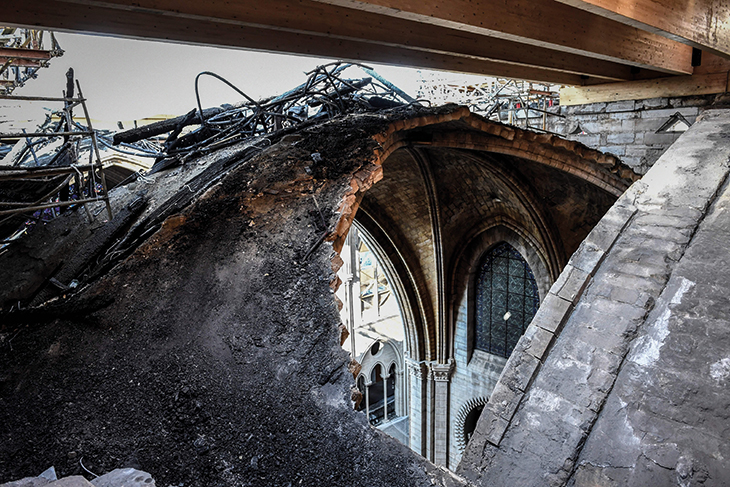
View of part of a destroyed ribbed vault in Notre-Dame during preliminary works in July 2019. Photo: © Stéphane de Sakutin/AFP via Getty Images
In France, architects seeking to specialise in conservation study for two years at the École de Chaillot, before being granted the title ‘architecte du patrimoine’. Restorations of listed buildings follow strict guidelines, inspired by the 1964 Venice charter, which says that ‘restoration stops where hypothesis begins’ and that ‘any extra work which is indispensable must be distinct from the architectural composition and must bear a contemporary stamp’. None of the heritage architects I speak to had been completely surprised by the fire. They know fires are common during works and the cathedral was in the process of being renovated, under the chief architect for historic monuments, Philippe Villeneuve. They had, however, all been puzzled by the reaction of politicians. ‘When I heard five years [to rebuild] I thought that was madness, a complete failure to understand what our profession is, what restoration is,’ says Wali Kengo, who works for a practice near the cathedral. She explains that in each French department, a DRAC (Direction Régionale des Affaires Culturelles) is responsible for the restoration of listed buildings, ‘So the government was effectively calling into question the existence of one of its services.’
‘I thought it was really bad that they called for an international competition,’ says another heritage architect, Charlotte Langlois. ‘The message it sends is we need international architects to have good ideas on how to restore our heritage and in particular our emblematic cathedral. And it’s very demagogical, to let people think that having well-known architects is the only way not to rebuild in the same way. It’s not true. We could very well rebuild differently without needing a famous or foreign architect.’ At the end of April last year, 1,170 conservation experts, academics, and museum curators signed an open letter, published in Le Figaro, calling for Macron to be careful with the cathedral’s restoration.
Langlois was part of a group of heritage architects who were firmly against the extraordinary law which was proposed after the fire. The architects were interviewed by the Senate, their objections part of proposed amendments that eventually were dismissed by the National Assembly. ‘What happened is quite typical of our current government,’ says Langlois, who compares it to the law declaring a state of health emergency that has just passed. ‘These are laws that are prepared in an emergency, which are written without even an inkling of what will be needed to legislate on. The idea is to create a law – in this case about the restoration of Notre-Dame – which will allow them to contravene a series of rules. This allows the government to act by decree, without passing laws, without going back and forth between the National Assembly and the Senate.’
Langlois says that the justification for the extraordinary law was the idea that one needed to act quickly but points out that heritage architects are used to intervening swiftly on a building to secure it. ‘Installing cranes and construction shacks in an emergency to save a building has never been a problem. So far the law hasn’t been used except to create a public body to manage the money that was given for Notre-Dame, led by a military man, General Georgelin,’ she says. Villeneuve, now assisted by two other architects, is still in charge of the renovation. Macron’s appointment of General Jean-Louis Georgelin, who had served as Jacques Chirac’s personal chief of staff and then as chief of the defence staff, has been criticised as a sign that the president wanted to rush through a complex and delicate process. And there have been clashes. Asked on RTL radio whether the five-year time frame for the restoration of the cathedral was feasible, the architect in chief said it was, but only if the restoration was to be identical. ‘Either I restore it identically, [and] it will be me [as the architect], or they make a contemporary spire and it will be someone else,’ Villeneuve said. Visibly bothered by this stance, which contradicted Macron’s initial suggestion about the spire, Georgelin, while attending a meeting of the cultural affairs committee of the National Assembly, said Villeneuve ought to ‘shut his mouth’, before being rebuked by the culture minister. ‘What worries us is what is probably going to come in six months to a year,’ Langlois says. ‘What choices will be made to restore the church and to restitute the structure, the roof, the spire? Will existing rules be infringed?’
The announcement of the plan for an international competition immediately prompted a series of informal proposals from architects around the world. Norman Foster’s studio imagined a spire, bigger and in glass and steel, accompanying an observation deck on a glass roof. The French firm Studio NAB proposed turning the roof into a greenhouse, with a new spire that would be a giant beehive. The Swedish practice UMA suggested installing a giant swimming pool on the roof. The 16 statues that had been removed from the cathedral just before the fire would be placed around it. ‘In the vacuum when nothing yet is decided, everything is possible, even our pool,’ UMA’s founder, Ulf Mejergren, tells me by email.
Many of these proposals focused on the spire and, by doing that, seemed keen to imagine a landmark on top of a landmark, as if the manifold meanings of Notre-Dame could only be manifested by a new creation looming over the skyline. James D. Graham, an American architectural historian and architect currently based in Paris says, ‘The thing that always strikes me, in these moments where the architectural community is taking initiative, is that, as much as people intend for their work to be differentiated from each other, for me the experience is one of absolute crushing banal sameness. […] It really speaks of a failure of the imagination of what architecture is and can do in this sort of moment.’
Olivier de Châlus, an engineer by profession, volunteered for 11 years as a guide to Notre-Dame. Like the majority of French cathedrals, Notre-Dame belongs to the French state, which is responsible for its maintenance and restoration, while the premises are put at the disposal of the clergy and open for worship for free. ‘I thought it was a shame that the debate became completely centred on whether we would rebuild an identical building,’ de Châlus says. ‘And we keep constantly talking about the Viollet-le-Duc spire. Well, he didn’t build it alone. I think it’d be good to take the time to say what it is that we had in this building.’
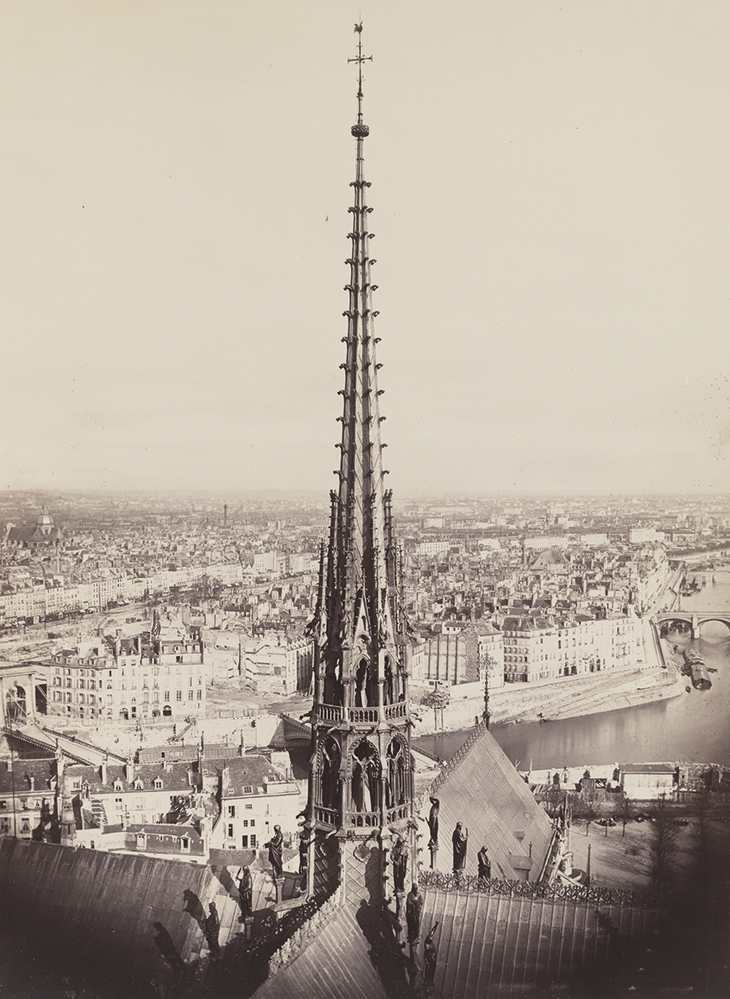
View of the spire of Notre-Dame looking towards the Île Saint-Louis and photographed in c. 1860 by Charles Marville. Library of Congress, Washington, D.C.
‘At the time it was built, the spire was this contemporary architectural gesture,’ says Nina Derain, who was writing a dissertation on the spire when it burnt. She explains that Viollet-le-Duc was despised by purists for a long time, before the coherence of his project was re-evaluated more positively in the 1980s. ‘The medieval spire had long been destroyed. The one he built was higher, more ornate, a giant growth on top of a building […] which belonged pretty much to his imaginary view of the Middle Age. It was, in a way, a strong contemporary architectural gesture. Not rebuilding it would probably mean casting Viollet-le-Duc into oblivion, but rebuilding an identical one bears the risk of negating what happened.’
With attention fixed on the spire, other potentially important discussions about what this building means and what its reconstruction could be are at risk of being forgotten. Frédéric Épaud is one of the few French archaeologists to specialise in Gothic timber work. He was supposed to study Notre-Dame’s Gothic timber structure, which was nicknamed ‘the forest’, but it burned before he could start. ‘In France,’ he says, ‘we have such a patrimony, the economy relies in great part on tourism, yet people don’t know a thing about this patrimony. Medieval history is only taught to 10-year-old children. Unlike heritage architects, contemporary architects don’t know a thing about patrimony. There is a complete ignorance of ancient architecture and often great contempt for it.’
Épaud thinks it is important to recreate Notre-Dame’s wooden structures in wood, and to use ancient techniques, not sawmills. Contrary to what was written in the press after the fire, this is both possible and ecological, he claims. He believes heritage architects working on the cathedral are keen to use these ancient techniques if they can. ‘In the 13th century,’ he says, ‘we made wooden structures like we did in the 1950s, with the same techniques of axe-cutting, respecting the wood’s thread, and only cutting down the necessary trees, that is to say trees with a diameter corresponding precisely to the beams needed. The beams will be much more resistant. And for carpenters, this could be an occasion to relearn their trade.’ Épaud likes to think that such a construction site could be an open school. ‘Of course, we could do as with Reims cathedral, or Chartres cathedral, make a metal or a concrete structure. We could even make a plastic structure! This could be an architectural gesture of the 21st century, but would we be able to look at ourselves in the mirror after that? I think that for many French people that wouldn’t be a problem, but we’d really have lost our soul.’
Langlois worries that one of the hidden agendas of the extraordinary law is to transform the surroundings of the cathedral, which is a listed site on the Île de la Cité. She worries the space could end up being turned into some sort of shopping arcade – a plan commissioned in 2016 by François Hollande suggested lining the island with leisure and shopping facilities – and that, because of the extraordinary law, there won’t be any way of opposing such a project.
Before Parisians were required to go into lockdown to slow down the spread of coronavirus, tourists were still going to Notre-Dame. ‘It was still a stop on the tour, but it had become a site of pilgrimage – a tourism of catastrophe rather than a tourism of patrimony,’ says Graham. At the time of writing, the cathedral remains closed, the works meant to protect the structure interrupted. Workers, who were using protective gear against lead, can’t effectively protect themselves against coronavirus as well. They’ll resume work after the lockdown finishes, if the companies they work for have survived. The police recently found two drunk thieves on the site, who were attempting to steal old stones. Cyril Isnart, part of a group of 15 academics meant to research people’s reactions to the fire for the next five years, says: ‘This catastrophe will survive the constant tide of the news. We’re lucky that Notre-Dame is still there, like a monument that is hurt but still alive. It’s still, perhaps because of the fire, to play for. A lot of things are going to happen in the next 10 or 15 years. We will have to – if possible, and if we want to avoid decisions to be taken from above – organise the conditions of a democratic debate. Notre-Dame will remain there, in the middle, and be a witness to what happens.’
From the May 2020 issue of Apollo. Preview and subscribe here.
Unlimited access from just $16 every 3 months
Subscribe to get unlimited and exclusive access to the top art stories, interviews and exhibition reviews.

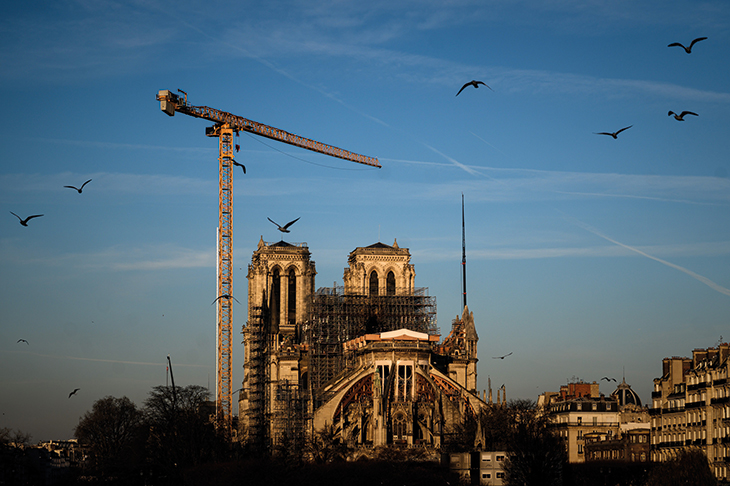
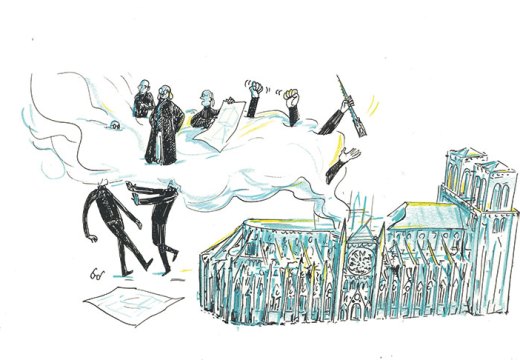
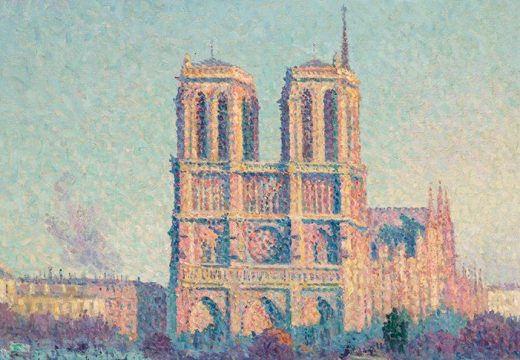
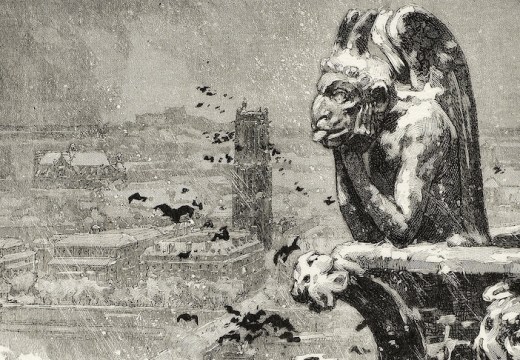









![Masterpiece [Re]discovery 2022. Photo: Ben Fisher Photography, courtesy of Masterpiece London](http://www.apollo-magazine.com/wp-content/uploads/2022/07/MPL2022_4263.jpg)
It’s time for the government of London to return to its rightful home